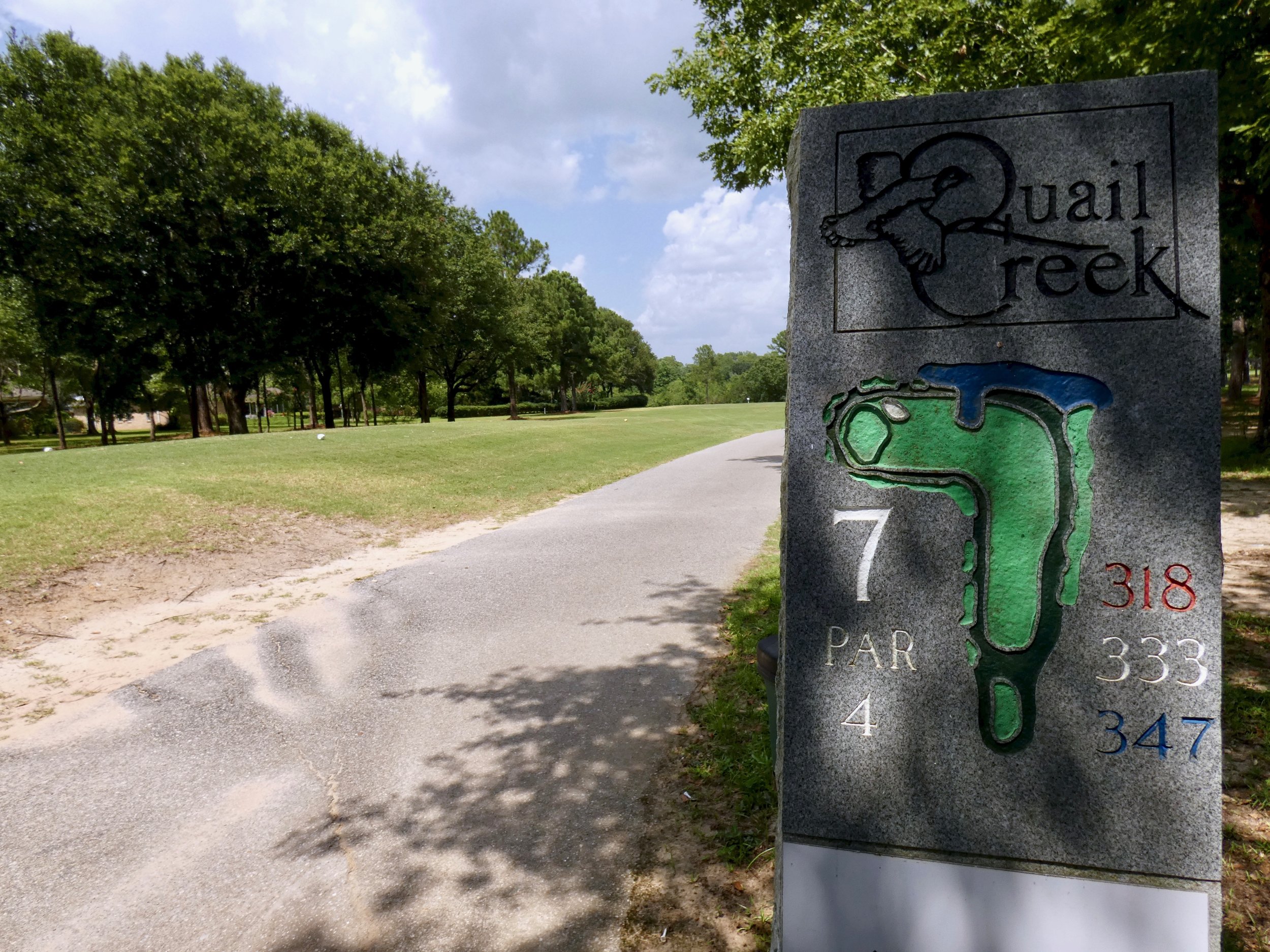An Obtrusively Residential Muni:
Home is Where the Cart Is
Quail Creek Golf Course
Fairhope, Ala.
July 5, 2019
Greens fee: $42 (18 holes with a cart)
Alabama’s Gulf Coast seems to have an inordinate amount of golf courses named after creeks. There’s Timber Creek; there’s Rock Creek (the Earl Stone design, not the Tom Doak design); there’s Soldiers Creek (“It does not possess any outstandingly remarkable values when compared to other rivers in the area,” the National Park Service wrote of the course’s namesake in 1984); and there’s Quail Creek. Keeping them all straight is no easy task: their mostly mundane layouts and haphazard conditioning run together, just like their names (although fairness demands noting that Rock Creek is far and away the least mundane of these).
But Quail Creek Golf Course in Fairhope brings together the worst of its monotonous, creek-inspired brethren into a single distillation. It is flat and surrounded by houses — the rare municipally owned residential course. Its fairways are brutally narrow, with white stakes often only a few clublengths from the fairway’s edge. And the course is literally straightforward: most of its holes are designed straight as a rifle barrel, although three fairways turn at 90-degree angles to cut around home lots. Conditioning is mediocre at best. It is golf for the sake of golf, without any underlying thought or effort apparent.
A greenside bunker guarding short and right at Quail Creek’s par-3 sixth hole.
The credit for this remarkably unremarkable golf architecture goes to Barney Shull — who was, at the time the course opened in 1988, not a golf course architect at all but a Fairhope city councilman. But that’s not even the weirdest thing to happen in Fairhope political history: the town was founded in 1894 as, essentially, a micro-socialist utopia. Today, the overwhelming majority of land in Fairhope is privately owned, but about 20 percent still belongs to the town.
Fairhope’s shift away from socialism was an unfortunate turn for Quail Creek, which would benefit from a redistribution of width.
. . .
To be clear, Shull did create a handful of fun holes — inadvertently, perhaps, but they’re there just the same.
There’s the 358-yard (from the white tees) par-4 fifth hole, which begins with a tee shot over a large pond to a fairway running diagonally to the golfer’s right. That lets the player choose how much of a carry to bite off with his drive — and the relative shortness of the hole begs for an aggressive line.
The short 14th hole’s spectacle bunkers, between which lies a run-up to a potentially drivable green.
And there’s the short, 298-yard 14th, with a run-up to the green flanked closely on both sides by spectacle bunkers: the hole’s length begs for an aggressive drive, and the course’s midsummer firmness make the green potentially reachable, but the bunkers demand an accurate shot. It’s the risk-reward conundrum that solid short par-4s always present.
And credit where credit is due: Quail Creek’s fairways stretch all the way up to the greens, so run-up shots are always in play — and in early July, with the course so firm, bouncing a half-shot with an iron toward the green makes a lot more sense for a 15-handicap than trying to pinch a wedge off a fairway that feels like a coffee table.
Quail Creek’s seventh is what happens when a city councilman with no golf design experience tries routing a residential course.
But even the few opportunities for quirky play go unrealized, because the course’s houses sit impossibly close to the fairways. For example, the fairway par-4 seventh’s fairway turns around a housing lot at a 90-degree angle; setting aside the awkwardness (“absurdity” would be more like it) of such a design, if ever there were a time to cut a corner and try for an aggressive line, this would be it. But a house sits squarely on line between tee and green. There are residential courses where the homes are merely an annoyance, and there are residential courses where the homes get in the way. If there’s a worse example of the latter than Quail Creek, then I’ve never found it.
. . .
I love municipal golf courses. I stick up for municipal golf courses. I tolerate conditioning at municipal golf courses that wouldn’t fly at other places. I judge municipal courses on a different scale than other courses because municipal courses are different. But Quail Creek has the feel of a place where no one is trying. And that’s hard to stick up for. At the first tee stands an abandoned starter’s shack, which since has morphed into a storage closet with peeling paint and faded bumper stickers. It’s a metaphor for the whole course: why is this here, and when did its caretakers give up on it?
In fairness, Quail Creek not only lacks “good bones,” it lacks any bones at all — it is architectural protoplasm, an uninspired mess that sits firmly on the bottom of its food chain. Given the diminishing returns that are inevitable at a place like this, I’m not sure how much sense stringent upkeep would make — particularly when the good money being thrown after bad would be tax dollars.
It’s an ironic conundrum, given Fairhope’s beginnings. Ultimately, utopias are a paradox: efforts at perfection that lead to unintentional, calamitous imperfection. That’s Quail Creek.



